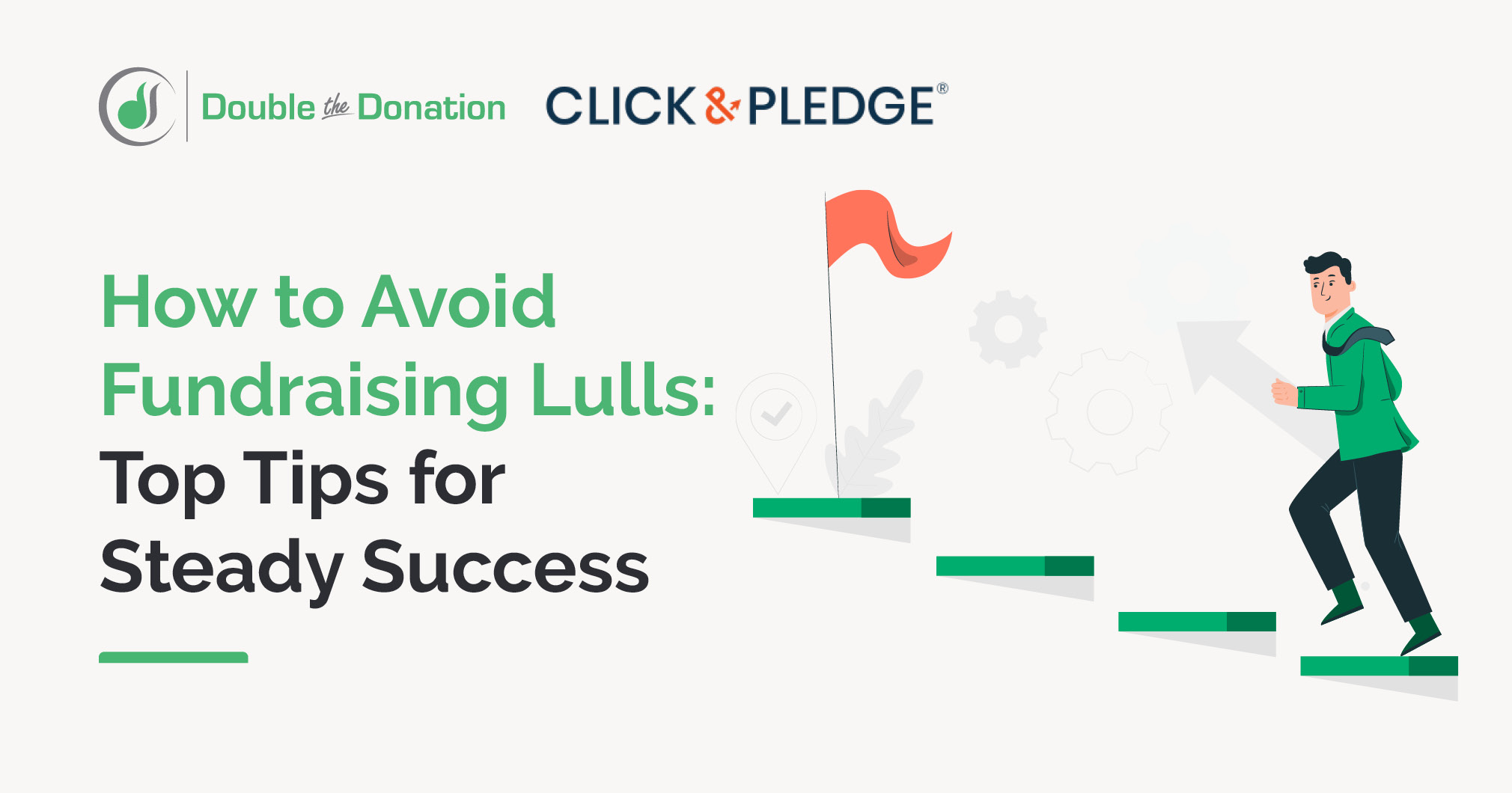
How to Avoid Fundraising Lulls: Top Tips for Steady Success
Most nonprofit fundraising initiatives depend on generous donor giving for success. But what happens when an organization starts seeing substantial decreases in fundraising revenue streaming in?
That’s typically called a fundraising lull. And in this guide, we’ll share four key ways to avoid fundraising lulls in order to maximize giving.
These include:
- Keeping supporters engaged after giving.
- Promoting recurring donation options.
- Diversifying your fundraising efforts.
- Prioritizing workplace giving opportunities.
But before we dive into top tips and tricks for avoiding fundraising lulls, let’s share a brief overview of what a fundraising lull is—and why these can be concerning for overall nonprofit efforts.
Let’s get started!
What is a fundraising lull?
A fundraising lull is essentially a period in which nonprofit fundraisers see decreased giving and is often tied to minimal donor engagement. These are nerve-wracking to charitable organizations for obvious reasons—after all, they’re not receiving the levels of fundraising success that they’re used to.
And they can happen for a few reasons, based on both internal and external factors at play. Here are some of the most common causes behind fundraising lulls:
Post-campaign slumps — One of the most-seen examples of fundraising lulls often takes place directly following a large and impactful fundraising push. Tons of donors may have gotten involved in your recent campaign efforts and may be waiting a bit before they come back for their next donation.
Donor fatigue — Perhaps your donors, though they still want to support your cause, have tired of the same old fundraising initiatives time and time again. In that case, they may be suffering from donor fatigue, and you may need to shake things up to get your supporters eager to be involved again.
Economic uncertainty — Maybe a slump has nothing to do with your organization and its fundraising efforts at all! There may be extenuating circumstances causing diminished fundraising success. One example of this has to do with economic downturns. If the market is trending downward, your typical supporter base may have fewer available resources at their disposal, sometimes leading to decreased overall charitable giving.
Best practices for overcoming fundraising lulls
Now that you understand what fundraising lulls are, as well as some of the main causes, we’re ready to explore key ways to avoid falling into this type of slump.
While periods of lower fundraising engagement are certainly natural (and even, in many cases, expected), there are a number of ways organizations can proactively involve their donors to keep these lulls at bay.
Consider these tried-and-true tips for doing so;
1. Keep supporters engaged after giving.
In a perfect world, the donor journey should not end after an individual clicks “submit” on their first (or even second, third, or fourth) donation. But keeping them engaged after a one-time gift can sometimes be a challenge.
Continuously engaged supporters, however, are less likely to fall into a fundraising lull. Thus, here are a few ways that you can keep your donors captivated long into the future:
- Send a thank-you letter (handwritten, or at least signed, for best results) that acknowledges their donation and shares key impact information.
- Promote opportunities for further involvement (invite them to an upcoming event, share corporate matching gift information, provide ways to stay connected through social media, email, etc.).
- Secure a “golden donation,” or second gift, within a timely manner (likely a few months after the first) to drive home engagement.
Not sure what to say? Use our free, post-donation email templates as a starting point!
2. Promote recurring donation options.
One of the best ways to avoid (or at least minimize) fundraising lulls is to increase the amount of regular giving revenue your organization can expect through automatic recurring donations. When your team knows to expect $X thousand in donations each month, it helps even out the difficulties faced during your “off months.”
Plus, donors love recurring gift options for the ease with which they can support their favorite causes in the long run. According to fundraising research from Double the Donation, one report indicated that monthly giving revenue grew by over 40% as recurring donations became increasingly accessible among nonprofit donors.
In order to promote the opportunity to supporters, we recommend adding the option to all of your organization’s donation forms. You might be surprised at how many donors select the option when available! Not to mention, it can be a great upsell opportunity for donors looking to do more to support your cause after their initial contribution.
3. Diversify your fundraising efforts.
While this next tip can certainly be a practice used to re-engage donors during a fundraising slump, it can also be a key way to avoid fundraising lulls altogether! When you aim to diversify your organization’s fundraising initiatives with new and creative fundraising ideas, supporters will be less likely to tire of getting involved.
Here are a few of our favorite ideas:
- Out-of-the-box fundraising event themes (think: costumed fun runs!)
- Surprise celebrity guests at nonprofit fundraisers
- Engaging social media challenges (i.e., the next ice bucket challenge?)
- Unique spins on traditional fundraising ideas (ex: hosting a dog wash alongside your car wash)
Talk about putting the “fun” in fundraising!
4. Prioritize workplace giving opportunities.
Workplace giving programs are offered by tens of thousands of companies across the globe—from Fortune 500 powerhouses to the local business down the road. And they can provide excellent ways for organizations to further connect with their individual donors while also developing essential corporate partnerships that benefit every party involved.
But do they help nonprofits avoid fundraising lulls? Certainly!
Here’s how:
- Workplace giving boosts overall fundraising revenue through corporate donations (approximately $2-3 billion is donated through matching gift programs each year);
- Workplace giving drives increased individual giving (simply mentioning matching gifts in donation appeals results in a 71% increase in response rate and a 51% increase in average donation amount);
- Workplace giving offers additional opportunities for nonprofits to engage with their donors post-transaction, keeping their missions at top-of-mind for longer.
In order to drive fundraising success through opportunities like matching gifts, volunteer grants, and more, we recommend taking a proactive approach to highlighting the programs to your network of dedicated supporters. Though more than 26 million individuals work for companies that participate in corporate philanthropy through employee giving, over 78% of the group has never been made aware of the opportunities available to them!
Thus, be sure to highlight corporate giving initiatives in your supporter communications, targeted donor follow-ups, and even within the giving experience itself.
The better your team can overcome fundraising lulls, the more regular giving revenue you can expect to receive. While they’re not likely to be avoided entirely, setting your nonprofit up for steady success can go a long way in your efforts to even out the ebbs and flows of typical fundraising.
And in the end, you can better equip your organization to continue proactively furthering your overall mission. Good luck!
Let’s do some good, together.

